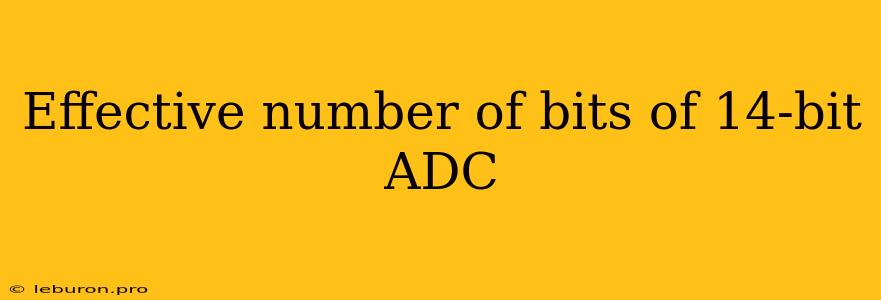The effective number of bits (ENOB) of an analog-to-digital converter (ADC) is a crucial metric that quantifies its performance. It represents the number of bits that the ADC effectively uses to represent an analog signal, considering noise and distortion. In this article, we will delve into the concept of ENOB and specifically explore the effective number of bits for a 14-bit ADC. We will discuss the factors that influence ENOB, understand how it relates to the overall performance of an ADC, and analyze the practical implications of using a 14-bit ADC with a specific ENOB.
Understanding Effective Number of Bits (ENOB)
The ENOB is a measure of the signal-to-noise ratio (SNR) of an ADC, which signifies how much the signal is stronger than the noise. A higher ENOB implies a better SNR and thus a more precise conversion.
Calculating ENOB:
The ENOB can be calculated using the following formula:
ENOB = (SNR - 1.76) / 6.02
Where SNR is expressed in decibels (dB).
Factors Influencing ENOB:
Several factors contribute to the degradation of ENOB, including:
- Quantization Noise: This inherent noise arises from the quantization process, where analog values are rounded to the nearest digital level.
- Non-linearity: Imperfections in the ADC's transfer function can introduce distortion and reduce ENOB.
- Thermal Noise: This noise originates from the internal components of the ADC, particularly the analog circuitry.
- Interference: External electromagnetic interference can corrupt the signal and affect the ADC's accuracy.
Effective Number of Bits of a 14-bit ADC
A 14-bit ADC theoretically has a resolution of 2<sup>14</sup> = 16,384 distinct levels. However, the effective number of bits may be less than 14 due to the factors mentioned above.
Example:
Let's assume a 14-bit ADC has a measured SNR of 70 dB. Applying the ENOB formula:
ENOB = (70 - 1.76) / 6.02 ≈ 11.3
This suggests that the ADC effectively uses 11.3 bits out of its theoretical 14 bits. This means that the ADC's performance is equivalent to a 11.3-bit ADC with no noise or distortion.
Implications of ENOB for a 14-bit ADC
The effective number of bits has significant implications for the performance of a 14-bit ADC. A lower ENOB implies:
- Reduced Accuracy: The ADC's resolution is effectively reduced, leading to less precise measurements.
- Increased Noise: The signal-to-noise ratio is lower, leading to a noisier output.
- Limited Dynamic Range: The ADC can only accurately measure a smaller range of signal amplitudes.
Therefore, it is crucial to consider the effective number of bits when choosing an ADC for a specific application. While a 14-bit ADC might offer high theoretical resolution, its real-world performance might be limited by its ENOB.
Optimizing ENOB for a 14-bit ADC
Several techniques can be employed to improve the effective number of bits of a 14-bit ADC:
- Noise Reduction: Implementing techniques like low-pass filtering or using a shielded environment can reduce noise and enhance ENOB.
- Calibration: Calibrating the ADC can compensate for non-linearity and improve its accuracy, leading to a higher ENOB.
- Oversampling: By acquiring samples at a rate higher than the signal bandwidth and then averaging them, oversampling can effectively reduce noise and increase ENOB.
- Dithering: Adding a small amount of noise to the input signal can spread the quantization error uniformly, improving the overall SNR and ENOB.
Conclusion
The effective number of bits is a crucial metric for evaluating the performance of an ADC. It quantifies the actual resolution achievable considering noise and distortion. For a 14-bit ADC, the effective number of bits may be lower than 14 due to various factors. Understanding the ENOB is critical when selecting an ADC for a specific application, as it dictates the actual accuracy and noise level of the conversion process. By optimizing factors like noise reduction and calibration, it is possible to improve the effective number of bits and enhance the overall performance of a 14-bit ADC.
